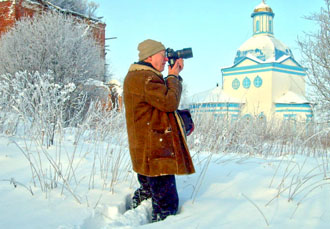Brumfield Documents Historic Monasteries
There he is, slogging through knee-deep Russian snow, camera in his gloveless hands, looking for the perfect shot of an ancient church building. Tulane professor William Brumfield remains determined to document Russian architecture. While his latest book depicts two monasteries founded in the 14th century, he just returned from working on a new project in the town of Ustiuzhna in northwestern Russia.

In the Russian north, professor William Brumfield tracks down the perfect photograph of a religious monument. (Photo provided by William Brumfield)
The newest volume by the prolific Brumfield part of a series on historic structures in the Russian countryside focuses on the Vologda region in the north and two of the country's most important monasteries: the Saint Kirill Belozerskii Dormition Monastery and the Saint Ferapont Nativity of the Virgin Monastery.
"I have visited and photographed them in summer and in winter since 1991," said Brumfield, professor of Russian studies at Tulane.
The structures are important, he added, "not only because of their strategic location in the north on the way to the White Sea (medieval Russian monasteries also served as outposts for defense and regional development), but also because of their architecture and extraordinary frescoes, painted as early as the beginning of the 16th century."
Brumfield's book, Kirillov. Ferapontovo, with text in both Russian and English, presents a survey of the architectural monuments in color and black-and-white photographs. It is available at the Howard-Tilton Memorial Library.
He pays special attention to frescoes in the north gallery at the Dormition Cathedral, one of the most important depictions of the Apocalypse in Russian art, and the interior of the Cathedral of the Nativity of the Virgin, which is on the United Nations Educational, Scientific and Cultural Organization's World Heritage List.
Brumfield is now completing work on the fourth volume in the Vologda book series.
His photographs also are featured by the Library of Congress in the World Digital Library, which recently expanded its collection of Brumfield's images online, including text available in seven languages about each image.
